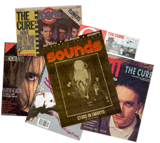The Cure -
"From the Underground to
the Top Level"
For
almost ten years, the charismatic Robert Smith has incarnated by himself
the image of The Cure. Surprising personality whose fantastic universe is
inspired as much by the books of Dylan Thomas, Cocteau or Camus as by the
records of the satanic Rolling Stones or the dark Jim Morrison. A decade of
breakdowns, tension, dreams and nightmares, punctuated by albums, sometimes
somber and grey, or flirting with a psychedelic pop according to Robert
Smith's frame of mind. Idolized today by the teenage throngs that crowd
their concerts, The Cure are aiming with their pop songs for the Top 50.
What does the future hold? Only Robert Smith, grand master of ceremonies
with feline movements, can say.
It is
impossible to retrace the path of The Cure without spending some time on the
childhood years of Robert Smith, its indisputable and undisputed leader.
Born on 21 April 1959 in Blackpool, Robert sees the day under the sign of
the Taurus. His father, employed in a large chemical products company,
belongs to the English middle class but does not deny in any way his working
class origins. He raises the four children in the respect of the catholic
religion and of the family. As you can see, it is not an unbalanced young
boy that we find between 7 and 15 in Crawley, a town in Sussex, but someone
who is bored by the grayness of a place too calm for a youth of his age.
Robert isn't the violent type, but learns very early to exorcise his moods
through writing, although without dreaming of being a star! No, he's almost
more interested in football than in rock. His brother, who plays the guitar,
tries to get him into playing classical guitar, but nothing happens, music
doesn't seem to be his path!
At
this time happen the two most important encounters of his life. Indeed, at
school he discovers Mary, the companion that he will always be close to, and
who is still, fourteen years later, sharing his life. "She is a
moderating element, she knows when to stop me when I'm tempted to go
overboard. She loves The Cure - but not always. I wouldn't say she is the
biggest fan of the group. Primarily because I spend more time with it than I
do with her. But I don't sleep with the group, not so far, at least!"
They
had been attending the same school forever, but it was on the school bus
that Robert met Laurence Tolhurst, who will become his musical alter ego for
ten years of The Cure. They were living two steps from each other, and soon
became inseparable friends, sharing the same musical tastes: the Rolling
Stones, Jim Morrisson, Jimi Hendrix (the first artist that Robert saw live
when he was 10; The Cure has also covered "Foxy Lady").
Around
this time, Robert doesn't fail to get noticed for his extravagant clothes,
his wild hair and a sometimes hysterical attitude. He has the luck to find
himself in an experimental school, very tolerant towards his eccentricity!
England is then caught in the big punk wave, the Sex Pistols phenomenon
being at its peak when Robert forms his first group in the family (with his
brother and sister), called the "Crawley Goat Band", which will become "The
Group" and then "Malice" with the arrival of Lol Tolhurst.
"We
were rehearsing at my house for the simple reason that my parents were a bit
better off than the others' parents and they had a house with an annex where
we could make noise. They helped me a lot in the beginning because they
understood immediately that music was something very important to me and not
a simple whim. This support was very important for us, but if we had played
bad songs, I am sure they would have thrown us out. Now they are regretting
that we don't rehearse at their place anymore, since all their neighbors are
asking them to make us come back in the neighborhood."
First Contract
First
true serious experience for Smith and Lol, the Easy Cure, formed in 1976. By
a stroke of luck, a Hansa producer gets interested in them and has them sign
a five year contract.
But
the Easy Cure / Hansa relationship soon proves discordant, so much that the
contract is terminated after six months. After eight months on the dole,
Robert Smith decides to finance a demo with his two accomplices, Lol
Tolhurst on drums and Michael Dempsey on bass, and himself on vocals
and guitar. The tape that is sent to various recording companies seduces an
artistic director from Polydor through its originality. More than just
signing them on, he offers to The Cure to become their manager and to set up
for them the Fiction label.
Killing An Arab
"I've
always written. For as long as I can remember. I have a pretty violent
nature, but it doesn't manifest itself physically. I don't break things up
around me, I prefer writing down whatever goes through my head. It is also a
way of fighting against that feeling of emptiness that we all have inside
us."
It was
thinking about the book "The Stranger" by Camus that he wrote "Killing An
Arab", released in February 1979. Despite a clear punk influence, this
jagged melody with an oriental flair causes vivid controversy for some, and
a sudden interest for others, yet a minority. Already from this first
single, The Cure troubles, intrigues, fascinates, shocks... One thing is
clear, a new group is born, with a new sound. The "Cure footprint" will
affirm itself with a first album, "Three Imaginary Boys", whose sleeve very
"pop art" will remain yet the clearest and least abstract of the Cure
discography. A sleeve that could have implied a desire for a clean image...
Well, in fact no, because since then Robert Smith will keep declaring that
the group has no image; as to the general atmosphere of the record, it has
more to do with dim, dark shadows than transparence! In May 1979, he writes
the first version of "Boys Don't Cry", one of the songs with a most curious
destiny, since after passing ten years totally unnoticed, it will become a
mega hit. It is with Siouxsie, the grand priestess of punk, that The Cure
embarks on its first tour around England. The fates of the two groups will
be closely linked from the day when Robert Smith, in the middle of the tour,
starts playing as a guitarist with the Banshees, anchoring thus both
parties.
Seventeen Seconds
In the
middle of preparations for the second album, differences in orientation
appear between Smith and Dempsey, and the latter decides to leave the group,
the first in a long list of itinerant musicians revolving around the central
duo. Simon Gallup, who replaces him, was a close friend and was already part
of the group's sphere. The lineup will only be completed with the arrival on
synths of ex-Mag Spies member Matthieu Hartley. "Seventeen Seconds" is
released in January, produced by Mike Hedges. The creative period
corresponding to the tensions between Michael and Robert is reflected on the
disc in themes of anti-sociability and the depression that it can cause.
Reviving psychedelia, The Cure is now at a crossing of encounters,
influences and new characters. If the record doesn't garner universal praise
among rock critics, it still has a respectable measure of success, ranking
20th in sales chart and 31st in the charts with "A Forest". During the
winter of 1980, the band performs in Europe. Matthieu Hartley, having not
really become an integral part of the group, decides to quit. "Faith",
produced by Mike Hedges, is released in 1981 amid general indifference.
Smith's existential spleen manifests itself through a voice increasingly
anguished, oppressive and tormented. This haunting side is omnipresent on
the most tortured record of the Smith-Tolhurst-Gallup trio. "I think
that throughout this period we were able to keep a certain sense of humor,
but it stayed hidden. We appeared morbid and depressed, but that's not how
we were in private!"
Pornography
A
morbid and religious record according to Smith, that, initially, was
supposed to be positive! After that, "Charlotte Sometimes", in October 1981,
was a respite, melodically and romantic, marking the end of the
collaboration with Hedges. When "Pornography" comes out, in April 1982, it
is a shock for all the fans. A diabolically violent record, draped in a
blood-red explosion visible at first sight on the cover in red and black, an
image supposed to represent a decomposing Marilyn on the satin sheets.
Murder, violence, drugs, the darkest impulses are witness to a personality
in increasing need of exorcism, but also to a certain abuse of LSD. For
Smith, it is also the beginning of a certain theatricality of image,
lipstick and deranged videos... During summer 1982, The Cure embarks on a
sold out tour, but a fight erupts in Brussels between Simon Gallup and
Robert Smith, which will result in eighteen months of separation, Gallup
going on to form "The Cry". Robert and Lol are by themselves. Laurence takes
advantage of it to switch from drums to keyboards. "Let's Go To Bed", the
single released in November 1982, has all the ingredients of a commercial
hit: addictive gimmicks, danceable rhythm... "It was a fantasy to
exorcise the trilogy", says Robert. And yet, the song will be far from
a big commercial success, and Smith decide to step back a little and join
the Banshees full time for two years as a guitarist. He gets together with
Steve Severin, with whom he shares a devouring passion for end of
the 60's psychedelia. Together they release an album, "Blue Sunshine", under
the name of The Glove. Just for fun, without any future plans!
Lovecats
Smith
comes back then on all fronts with a tour of The Cure in the USA, then, in
September, in Israel with the Banshees. The Tolhurst/Smith duo takes the
opportunity to release the synth-based 45rpm "The Walk", then another
single, this time oscillating between jazz and funk, "The Lovecats",
recorded in France, in Paris, with two new musicians: Phil Thornalley on
bass and Andy Anderson on drums. Looking for a revival, Smith seems to reach
a goal that he had never set for himself: attaining wide popular success and
becoming a global rock star. While participating on the Banshees' album
"Hyaena", Smith works on "The Top", with a sleeve that reflects once more
the singer's colored hallucinations. "A return to origins", will say some at
the release of the disc. "It wasn't conceived in a group spirit. The
group didn't really exist anymore. I played all the instruments, I entirely
made this disc."
The Head on the Door
A
month later, Robert collapses and quits the Banshees. Many think that he
would also end the career of The Cure. To their relief, it was only a new
departure in order to rebuild a true solid group. He meets again with Simon
Gallup, gives him the demos for "The Head on the Door" to listen to, and
convinces him to rejoin The Cure. Boris Williams (ex-Thompson Twins) becomes
the new drummer. "The Head on the Door", while not surprising either the
band's fans not the rock critics, seduces the wide public. Each song has its
own logic.
Boys Don't Cry
The
Cure pushes to its paroxysm the idea of a music rich in colors and continues
the multicolored effects of "The Top". Everyone thinks that the tortured
universe of The Cure is then forgotten, on discovering such pop songs as
"Inbetween Days". "It is a bit of an exaggeration, but everything that
is being said about The Cure is a caricature. I suppose we have a quite
well-balanced image. Today, we want to show another aspect of our lives, the
lighter side, so perhaps more cheerful. That doesn't mean we spend our lives
laughing. We are simply normal." There are new influences for The Cure,
such as "Kyoto Song", or a flamenco rhythm. "We we just trying to sound
like a Spanish group that wanted to sound English, and we also tried to
figure out how a Japanese group would write an English pop song. It's an
experience." For the first time, The Cure finds itself No.1 in England,
and then invades in force our Top 50 with "Boys Don't Cry" after "Close To
Me" and "Inbetween Days". "For us, it has been the same motivation ever
since our debut. I am still disappointed by the music I hear, I don't like
the bands of my generation. That's why we are always trying to make songs
that sound good. I like though Echo and the Bunnymen and New Order. If being
successful meant having a different attitude, I wouldn't last long. It's bad
for my mental health." The USA and Europe are reserving the biggest
venues for the tour that will follow the release of "The Head on the Door".
"I
would rather be playing in front of 3,000 people, it's the ideal audience,
but today that would mean being on tour the whole year just to play to the
same number of people. In the United States, we have played in small
theaters but also in front of 15,000 people in Los Angeles. We will continue
playing small places. In London, we had the choice between playing seven
nights at the Hammersmith Odeon or one night at Wembley. No band had played
Wembley before us. We decided to take the risk and it was the best concert
of our career, even though many people said it was going to be a disaster.
We wanted to prove what The Cure could do. Groups very popular in France
give bad concerts at the Bercy, like Spandau Ballet or Howard Jones, not
because of the venue, but because they're worthless." Summer
1986 will belong to The Cure. While most of the French singers' tours turn
to disaster, The Cure fills the arenas of the South of France. People speak
of Curemania, even though, on the way, The Cure has lost its first fans. "In
the end, it has nothing to do with me if people liked 'Pornography' and not
the others. We are definitely not going against what we have done
previously. Each record is the fruit of a different Cure. Each album exists
in and of itself and not in relation to the global concept of The Cure.
People would like us to make 'Pornography' every year, when it's already
been done. One step, that's all!" The Cure don't deny their past,
releasing a singles compilation, "Standing on a Beach."
"I
can't believe we have already been around for ten years. When I look at the
discography, I can't believe that we can still make records. And yet, I
still feel like in the beginning. It is above all due to the numerous
changes in the group; every time, I have the feeling I am starting something
new. It is by looking at old photos and listening again to old discs that I
realized how long the group had existed. In the end, one could say we've
made a lot of good records."
The
Cure is today a mythical group and they are preparing to record a new album
in a studio near Marseille. Most insistent rumors tell us even that Robert
Smith has decided, for a while, to live in France, a country that he has
always felt attached to.
--
Photo legends:
page
4, top left: "I would put on make-up to look as if I'd been punched in the
mouth and my eyes were bleeding."
page
4, top right: "I entered the bar where we were going to meet; I walked
towards Simon and talked with him; after eighteen months of silence, he was
once again part of the group."
page
5, top left: "For 'The Top', I wrote, sang and played all the songs."
page
5, top right: "I would rather play football than be taken for an
existentialist!"
pages
14, bottom: "I hate religion as much as nationalism." (Robert Smith)
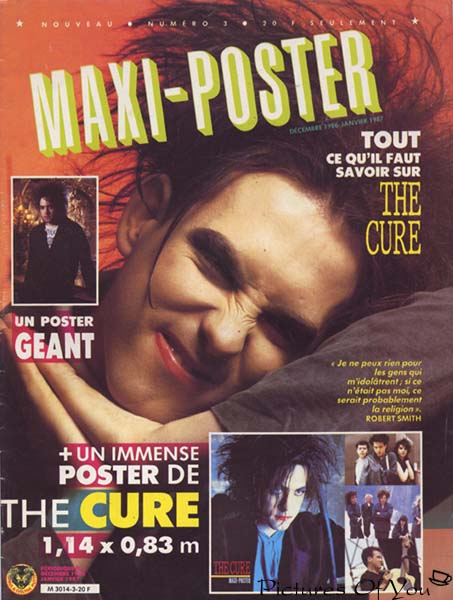
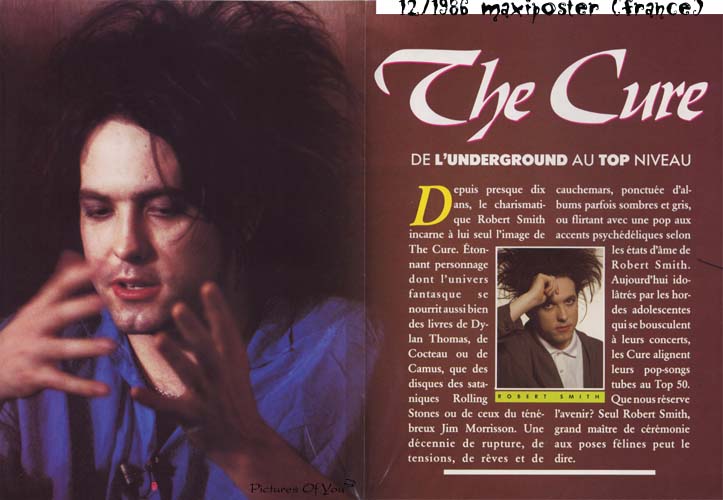

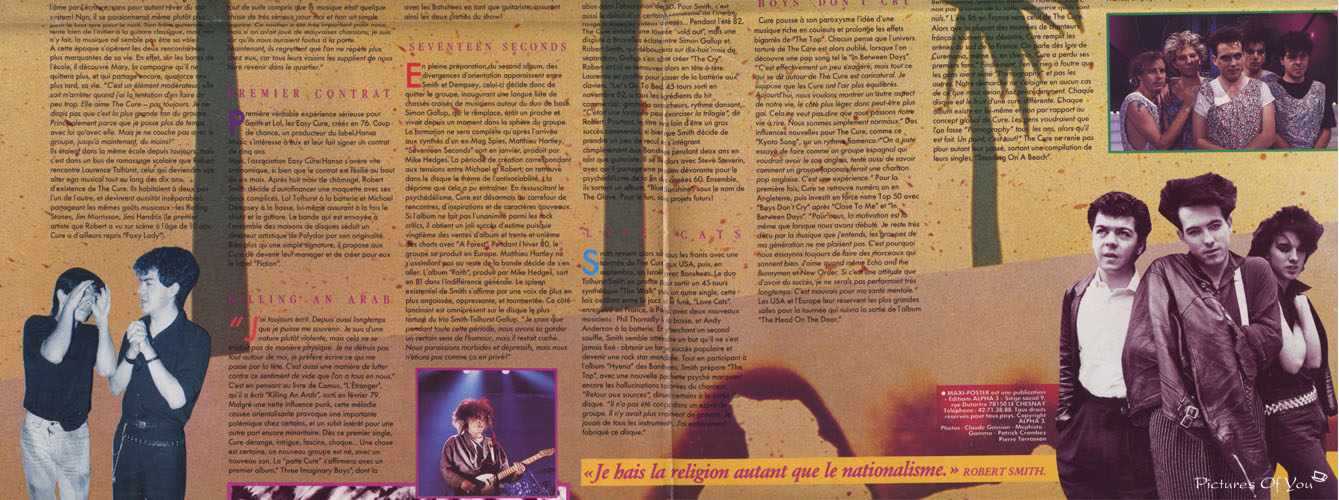
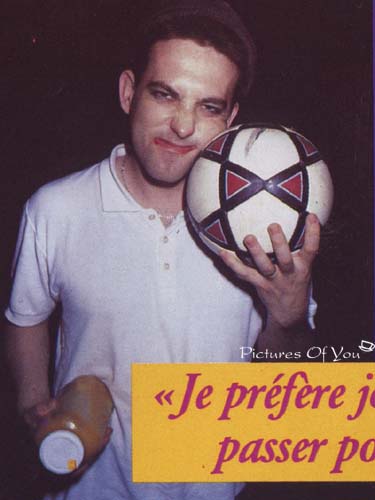
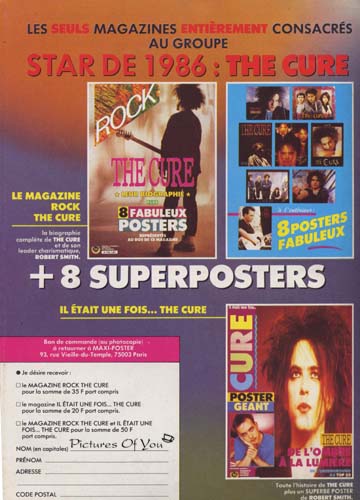 (backcover)
(backcover)




 (backcover)
(backcover)